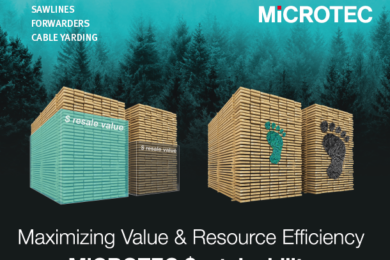There has been much reported concern recently about continuing deforestation in Amazonia. But there are of course some sustainable operations there. One reported recently by Reuters is a plantation operation on the Jari River in northern Brazil, which “is being hailed as a model for preserving the world’s largest rain forest.” Located in the heart of Amazonia, the Jari industrial complex (http://www.jari.com.br/) has an annual production capacity of 360,000 t of bleached short-fiber eucalyptus woodpulp. Jari is part of Grupo ORSA. Its forests are certified by the Forest Stewardship Council (FSC) and all the woodpulp produced by Jari Celulose comes solely from sustainable eucalyptus plantations.
“Selling certified timber harvested in a sustainable way is the only solution for the Amazon,” Augusto Praxedes Neto, a manager at Grupo ORSA told Reuters. See http://www.planetark.com/dailynewsstory.cfm/newsid/47026/story.htm Jari Celulose harvests only 30 m2/ha of timber every 30 years, just under the natural regeneration rate. Trees are felled and transported so as to cause minimal impact on the forest and are recorded in a computerised inventory. “I can tell a customer in Europe which tree his table is made of,” Operations Manager Euclides Reckziegel told Reuters. In contrast, “illegal loggers kill 30 trees to get one. These projects protect far more trees than they extract,” Ana Yang of the FSC in Brazil told Reuters. The FSC certifies and inspects the Jari project every six months. Harvesting began in 2003. Much of Para state surrounding the Jari Celulose is troubled by the kind of land disputes that cause death and destruction throughout the Amazon. In one such dispute in February 2005, Dorothy Stang, a US nun and human rights activist, was killed by gunmen hired by ranchers. Jari’s 1.7-Mha is just over half the size of Belgium. Roughly 80% of it is standing forest and one-third is managed and FSC certified. “If the government were to put the same effort into sustainable forest management that it put into developing agriculture in the 1970s and 1980s we could preserve much of the Amazon,” Judson Ferreira, a senior researcher with government farm research institute Embrapa, told Reuters. The government is taking a more cautious approach. In March it will select three companies to manage just 96,000 ha of forest, the first such tender of federal land. “Forestry management is a great alternative and ORSA is a good example of it but we want to take things slowly,” Tasso Rezende, Head of Brazil’s forestry service, told Reuters. “We need several projects doing well over a long period — private ownership in the Amazon is controversial.” For forestry management to take off, authorities need to tackle uncertainty over land ownership, crack down on illegal deforestation, and cut red tape, Yang said. “It’s still easier to get a license to cut trees than to plant or manage them,” she said.






